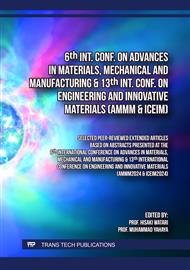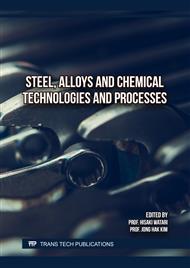[1]
S. Goswami, C. Anitescu and T. Rabczuk: Adaptive fourth-order phase field analysis for brittle fracture. Computer Methods in Applied Mechanics and Engineering 361, 112808 (2020)
DOI: 10.1016/j.cma.2019.112808
Google Scholar
[2]
J.A. Stewart and R. Dingreville: Microstructure morphology and concentration modulation of nanocomposite thin-films during simulated physical vapor deposition. Acta Materialia 188, 181–191 (2020)
DOI: 10.1016/j.actamat.2020.02.011
Google Scholar
[3]
I. Beyerlein and A. Hunter: Understanding dislocation mechanics at the mesoscale using phase field dislocation dynamics. Philosophical Transactions of the Royal Society A: Mathematical, Physical and Engineering Sciences 374(2066), 20150166 (2016)
DOI: 10.1098/rsta.2015.0166
Google Scholar
[4]
A. Hunter, F. Saied, C. Le and M. Koslowski: Large-scale 3d phase field dislocation dynamics simulations on high-performance architectures. The International Journal of High Performance Computing Applications 25(2), 223–235 (2011)
DOI: 10.1177/1094342010382534
Google Scholar
[5]
A. Vondrous, M. Selzer, J. Hötzer and B. Nestler: Parallel computing for phase- field models. The International journal of high performance computing applications 28(1), 61–72 (2014)
DOI: 10.1177/1094342013490972
Google Scholar
[6]
Q. Du, X.Feng: The phase field method for geometric moving interfaces and their numerical approximations. Handbook of numerical analysis 21, 425–508 (2020)
DOI: 10.1016/bs.hna.2019.05.001
Google Scholar
[7]
T. Fast, S.R. Niezgoda and S.R. Kalidindi: A new framework for computationally efficient structure– structure evolution linkages to facilitate high-fidelity scale bridging in multi-scale materials models. Acta Materialia 59(2), 699–707 (2011)
DOI: 10.1016/j.actamat.2010.10.008
Google Scholar
[8]
C. Hu, S. Martin and R. Dingreville: Accelerating phase-field predictions via recurrent neural networks learning the microstructure evolution in latent space. Computer Methods in Applied Mechanics and Engineering 397, 115128 (2022)
DOI: 10.1016/j.cma.2022.115128
Google Scholar
[9]
D. Montes de Oca Zapiain, J.A. Stewart and R. Dingreville: Accelerating phase- field-based microstructure evolution predictions via surrogate models trained by machine learning methods. npj Computational Materials 7(1), 3 (2021)
DOI: 10.1038/s41524-020-00471-8
Google Scholar
[10]
L. Lu, P. Jin, G. Pang, Z. Zhang and G.E. Karniadakis: Learning nonlinear operators via deeponet based on the universal approximation theorem of operators. Nature machine intelligence 3(3), 218–229 (2021)
DOI: 10.1038/s42256-021-00302-5
Google Scholar
[11]
Z. Li, N. Kovachki, K. Azizzadenesheli, B. Liu, K. Bhattacharya, A. Stuart and A. Anandkumar: Fourier neural operator for parametric partial differential equations. arXiv preprint arXiv:2010.08895 (2020)
Google Scholar
[12]
V. Oommen, K. Shukla, S. Goswami, R. Dingreville and G.E. Karniadakis : Learning two-phase microstructure evolution using neural operators and autoencoder architectures. npj Computational Materials 8(1), 190 (2022)
DOI: 10.1038/s41524-022-00876-7
Google Scholar
[13]
C. Lin, Z. Li, L. Lu, S. Cai, M. Maxey and G.E. Karniadakis: Operator learning for predicting multiscale bubble growth dynamics. The Journal of Chemical Physics 154(10) (2021)
DOI: 10.1063/5.0041203
Google Scholar
[14]
V. Oommen, K. Shukla, S. Desai, R. Dingreville and G.E. Karniadakis : Rethinking materials simulations: Blending direct numerical simulations with neural operators. arXiv preprint arXiv:2312.05410 (2023)
DOI: 10.1038/s41524-024-01319-1
Google Scholar
[15]
A. Paszke, S. Gross, F. Massa, A. Lerer, J. Bradbury, G. Chanan, T. Killeen, Z. Lin, N. Gimelshein, L. Antiga and A. Desmaison: Pytorch: An imperative style, high- performance deep learning library. Advances in neural information processing systems 32 (2019)
Google Scholar
[16]
S.M. Allen and J.W. Cahn, : A microscopic theory for antiphase boundary motion and its application to antiphase domain coarsening. Acta metallurgica 27(6), 1085–1095 (1979)
DOI: 10.1016/0001-6160(79)90196-2
Google Scholar
[17]
J.W. Cahn: On spinodal decomposition. Acta metallurgica 9(9), 795–801 (1961)
DOI: 10.1016/0001-6160(61)90182-1
Google Scholar
[18]
D. Hendrycks and K. Gimpel: Gaussian error linear units (gelus). arXiv preprint arXiv:1606.08415 (2016)
Google Scholar
[19]
G. Klambauer, T. Unterthiner, A. Mayr and S. Hochreiter: Self-normalizing neural networks. Advances in neural information processing systems 30 (2017)
Google Scholar



